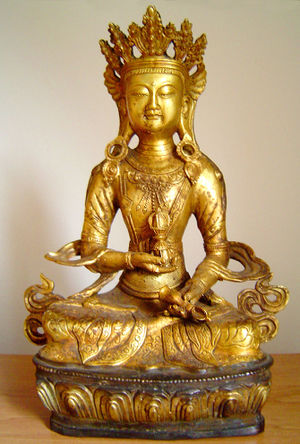Vajrasattva (Dhyani Buddha)

Vajrasattva represents the synthesis of the Five Dhyani Buddhas, a group of five non-historical celestial Buddhas who are visualized during meditation. They are to be distinguished from historical Buddhas, such as Gautama Buddha or Padma Sambhava.
Together with Vajrasattva, the Five Dhyani Buddhas are the central deities of esoteric Buddhism. They represent five different aspects of enlightened consciousness and are guides to our spiritual transformation. In Tibetan Buddhism, student meditators are introduced to the experience of meditation on the Five Dhyani Buddhas through the “sixth Dhyani Buddha,” Vajrasattva.
The purpose of our meditation on these celestial beings is to help us awaken to the potential of our own Buddha nature and to find oneness with the Buddhas. These Buddhas also reflect back to us how the components of our consciousness can be transformed into wisdom.
Vajrasattva’s name means “Diamond nature,” because he represents the essence of our own pure, diamond nature. He is the role model of the devotee, and to become like him we must internalize the wisdoms of all the Dhyani Buddhas, for Vajrasattva has the attainment of all five.
Vajrasattva is invoked at the beginning of many Tibetan initiations. Here candidates meditate on him and recite his mantra to purify themselves and prepare for further advancement on their path to enlightenment. Ultimately, the devotee comes to realize that Vajrasattva is to be found in the center of his own being, seated on a lotus throne in the secret chamber of his heart.
The service of the Dhyani Buddhas
In 1993, Vajrasattva, as spokesman for the Five Dhyani Buddhas, described how they assist us: “We excel in helping you unlock your inner being, the secret chamber of the soul that has been sealed off to the soul by karma and inordinate desire. We unlock inner doors, and the right door, I tell you, is the open door to all the rest.
“Once the soul has the courage and you prompt her, support and direct her and bathe her in love and compassion, she will open that door and walk through. And because you have tended her needs, your soul will know her own Inner Christ” and her own Inner Buddha.[1]
A visualization of Vajrasattva
You can visualize Vajrasattva as a golden Buddha—shining as though illumined by the dazzling rays of the sun. He is seated in full lotus posture, and he holds a vajra scepter in his right hand at the level of his heart. In his left hand, he holds a bell.
The vajra represents his compassion, and the bell represents his great wisdom. Compassion and wisdom are the twin virtues essential to the attainment of self-realization. On another level, the vajra and bell symbolize a Buddha’s enlightened mind and body in blissful union with ultimate Reality.
Written around the heart of Vajrasattva are the letters of his bija mantra, Hum. The bija of a Buddha is the sacred sound, the sacred syllable that represents his essence. We meditate upon the essence of Buddha through his bija mantra. The letters H-U-M are white and they move clockwise around Vajrasattva’s heart, emitting sparkling rays of white light.
Vajrasattva is seated on a throne that is formed by a large, white, thousand-petaled lotus. He is smiling his smile of great compassion, and he is looking down upon you with tender love. As the whirling letters in his heart spin faster and faster, his whole body turns whiter and brighter until it appears to be all light. His body becomes transparent. You no longer see his form. You only see light, light, light.
The power of the mantra
Vajrasattva explains one important spiritual service that is performed through the recitation of the mantras of the Five Dhyani Buddhas:
Each time you have recited our bija mantras, you have pulled us to the very levels of the earth, you have pulled us to the very levels of the astral plane, you have pulled us to the lowest levels of incarnation of all souls who are karmically tied to you....
Therefore we follow the mantra. We follow the point of origin of the Word. We follow those who give the recitation of the bija mantras, the seed syllables unto the Divine Mother, unto the Goddesses, unto the Dhyani Buddhas, unto the entire hierarchy of Buddhas.
Therefore, the point of the sounding of the mantra calls the one whose mantra it is to that point. Thus, you have successfully called us to the depths of the astral plane ... by the remaining ties that you have to lifestreams who are abiding in those levels.
We consider this to be a great boon! For unless the Law would dictate otherwise unto us, we are subject to that law whereby we cannot descend any lower in the planes of earth than where there is a tie to one of our disciples....
Know, then, beloved, that you have now carried us and our bodhisattvas and our disciples and chelas to all levels. And therefore we have duplicated ourselves as we have manifested our presences in a million different points of light at all levels of evolution in the Matter cosmos.[2]
Vajrasattva’s six-syllable mantra is Om Vajrasattva Hum.
See also
Vajrasattva is also a term used to describe a state of attainment that may be reached by one who is close to liberation, or nirvana. See Vajrasattva.
Sources
Mark L. Prophet and Elizabeth Clare Prophet, The Masters and Their Retreats, s.v. “Vajrasattva.”
